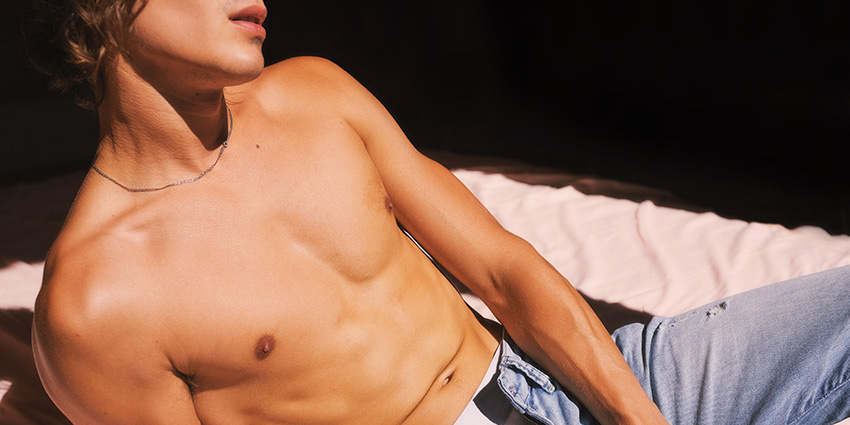Enjoy our interview with certified sex therapist, Casey Tanner, who discusses readers’ questions about gender and sexual expansiveness.

Q: Where can I find queer-positive, LGBTQ+ porn?
It is certainly more difficult to find queer porn that doesn’t feel tokenizing or made for the male gaze. I find that the best, most ethical queer porn—or really any kind of porn—is behind some type of paywall.
Some people may feel uneasy about paying for porn. But, by paying for it, you’re contributing to equal and fair wages for sex-workers and improved working conditions for queer people that work in the sex industry.
Don’t hesitate to pay for porn! You’re much more likely to get material that is high-quality and ethically made.
Q: How do you deal with others being biphobic towards you, especially in regard to expressions of femininity/masculinity in your bisexuality?
Unfortunately, biphobia is still all too common. Bisexual women are often accused of being straight women who are experimenting, and bisexual men are often accused of being closeted gay men.
If someone is doubting your bisexuality because of the way you present in terms of gender expression, what they’re doing is making an error in not differentiating between sexual orientation and gender expression.
Gender expression and sexual orientation are completely different components of identity and don’t have anything to do with one another. Your gender expression might be masculine/feminine, but your attraction as a bisexual person is to people of multiple genders.
People who are being biphobic towards you in regard to your gender expression are confusing that with your sexual orientation. When this happens, try to remind yourself (or them): gender expression has nothing to do with sexual orientation.
Q: The ways I want to express my sexuality feel so heteronormative. Is that wrong?
No, it makes perfect sense that your expressions of sexuality might feel and look heteronormative because heteronormativity is what you were taught and what was modeled for you.
If you are someone who wants to express themselves in a way that’s more queer, the best way to break open the box of compulsive heteronormative sexuality is to expose yourself to queerer, more expansive ways of expressing sexuality.
You can start by finding media—watching shows like Pose on TV, or even the newer seasons of The L Word—that speaks to queer sexuality/romance and queer experience. Additionally, following queer creators who are talking about expansive sexuality (I do that a lot on my page) or reading books by queer authors will also help you deconstruct heteronormativity.
Because what you’ve been exposed to up to this point is heterosexuality, by exposing yourself to queerness you can undo and unlearn compulsively heteronormative ways of sexual expression.
Q: I’m a person who hasn’t had same-gender sex. Am I behind?
The concern about “being behind” in terms of sexual experience is common, particularly for people who are coming out a little later in life. What you should try to remember when these feelings arise is that it’s not you that’s behind: it is the world and our culture that’s behind in in terms of offering you the sex education that you deserved, as well as the knowledge that it’s more than okay to express yourself sexually however you choose.
It is important to keep in mind that, because the world is behind, development of sexuality for people in the LGBTQIA+ community often does happen later in life. For example, research shows that people who are bisexual are likely to come out later in life.
Additionally, people in the LGBTQIA+ community are more likely to have same-gender sexual experiences later in life. It is perfectly normal for someone to not have had these experiences in their 20s, 30s, 40s and beyond. If you are feeling this way, you are not behind: your timing is perfect, your timing is queer, just like you!
Q: I love my partner, who is the opposite sex from me, but I think I might be gay…what do I do?
There are many different types of love: platonic love, committed love, familial love, sexual love, and romantic love. It sounds like you have many different types of love for your partner, but perhaps sexually and romantically the love and sexual attraction you have is directed in a way that’s more queer.
To address this, you have a lot of options in front of you. There is no one right way here, and I would start by asking: “What feels like the most authentic path forward for me?” Don’t be confused by thinking that “coming out” is the only way to be authentic. For some people, it is! But, for other people, making a marriage work by opening the relationship or having these conversations with your partner is an equally authentic way of moving through this situation.
If you think that your partner can hold space for this part of you, I might start by sitting down together, maybe with the support of a therapist, to have a conversation about what’s been going on inside of you so that you don’t have to hold this in and deal with it all by yourself.
Q: How can I feel validated in my queerness when having “straight sex?”
Straight sex happens when one or more straight people engage in sexual activity. If you are a queer person engaging in sexual activity, you are not having “straight sex,” you are having queer sex because you are a queer person.
The way that you move your bodies, whether you’re having penetrative sex or not, that has nothing to do with whether or not the sex you’re having is queer or straight.
The internal sense of the identity you have has everything to do with whether you’re having queer or straight sex. So, even if you’re a cis-woman having sex with a cis-man, if you’re queer, you are having queer sex.
Q: I don’t know whether I’m asexual or not. How do I discover my sexuality?
Asexuality can be a particularly difficult identity to narrow down for people because it can be confusing in differentiating between asexuality and a low sex drive, or asexuality and difficulty with sex because of trauma. There’s no right or wrong reason to identify as asexual.
In this answer, I’ll include a couple of thoughts that might help you get started. If you find that every so often you have a desire to masturbate or have sex with someone because you feel your body getting aroused, though it does not happen that often, you may be someone who has a lower libido or low sex drive.
If you’re someone who, across time, doesn’t really experience arousal or an internal desire to pursue sex with partners, or if you find that you are not sexually attracted to other people, you may be more on the asexual spectrum.
One of the things you might find useful to remember is that many asexual people choose to have sex for reasons outside of internal arousal. They might choose to have sex because they find that sex is fun, or because it matters to a partner, or because they’re just curious about it! So, choosing to have sex doesn’t disqualify you from being asexual either.
Q: How do you distinguish the difference between enjoying wearing a strap-on and actually wishing that you had a penis?
One way that you can differentiate between these two is to ask yourself how you feel about the genitals you do have.
If you’re someone with a vulva, how do you feel about it? Do you like it? Do you like being able to add a strap-on occasionally, to mix up the type of sex that you have? In those cases, you might be somebody who just enjoys using a strap-on.
But, if you’re someone who experiences dysphoria around your vulva, or it causes you distress, or you don’t really want it to be touched or enjoy having sex using it, or wearing a strap-on actually makes you feel more confident all the way around—maybe you even wish you could wear it all day—then you may be somebody who’s experiencing some gender dysphoria or wishing that their body looked differently to match their internal sense of self.
No matter what feels right for you—the fact that you’re asking these questions and doing this self-introspection means you’re on the right path to discovering the answer!
